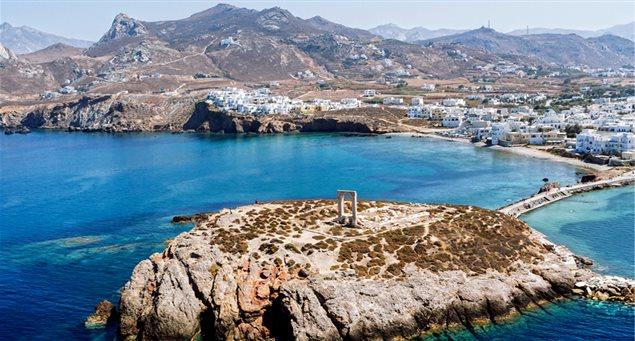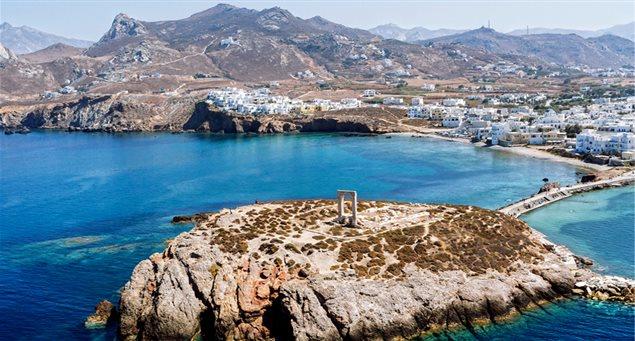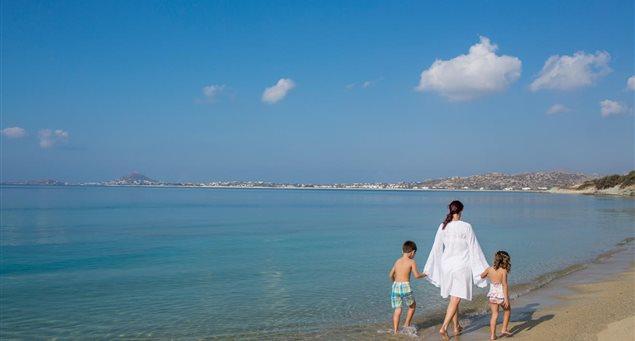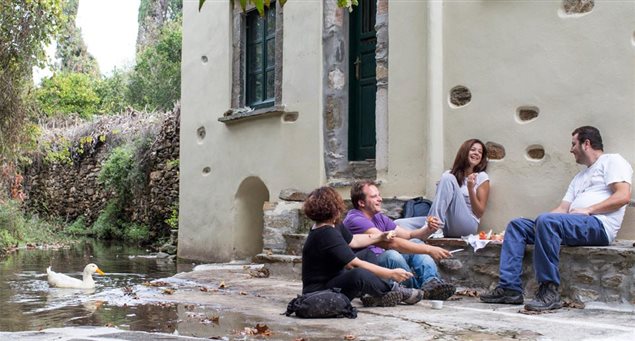
Experience Naxos, the Cyclades’ largest island! This little city island with endless stretches of sandy beaches, fertile valleys and mountain villages offers so much to see and do.
Encircling the isle of Delos, is a group of islands known all over the world as the Cycladic Islands. In the centre is Naxos, the largest and greenest of the group. It is also, according to Greek mythology, the birthplace of the god of wine, Dionysus, and the place where Zeus grew up as a child.
Shaped like a diamond, or as some say, like a green leaf on the Aegean, it boasts a fertile land, due to its many natural sources of irrigation. This natural phenomenon has provided the island with a vibrant industry of agriculture and self-sufficiency apparent by the many products the island produces, including cheese and dairy, meat, olive oil, honey, fruits and vegetables and sweet preserves. Must-try items include Naxian cheese (there are several varieties); potatoes (they are considered to be amongst Greece’s best); and the liqueur made from the leaves of the Citron fruit, indigenous to Naxos.
And that’s not all. The island is also a natural resource of marble and emery, with skilled craftsmen providing the region with the material used to build many mythical monuments for millennia.
Remains of these temples and other significant artefacts are found throughout Naxos, making it an ideal place to see up close, the temples and mythical legends we read about in books: The Temple of Demeter; The Temple of Apollo; the sanctuary at Yria (temple dedicated to the god Dionysus); the giant “Gulliver-like” statues Kouroi and the medieval castle above Naxos’s Old Town.
A civilization that dates back to the 4th millennium B.C., Naxos, since ancient times, has been a pivotal hub connecting travellers and nomads to destinations near and far.
It has also been a crossroads of many cultures and religions, ruling kingdoms, dukes and emperors, apparent by the various architectural styles and religious monuments on the island: from Venetian towers and styles in the Old Town, to the over 200 Byzantine churches high atop mountain peaks and nestled in between green valleys and ravines.
In recent years, the charming villages of Naxos have claimed their own in the world of travel destinations, offering a visit into village life in real time. In fact, Naxos was recently named “Best traditional village life:Naxos” in a CNN article titled “Which Greek island should you go to?”
Undoubtedly, the main attraction to visiting Naxos is its breathtaking coastline. Scores of endless sandy shores, some easy to get to, and others more remote, provide the option of easy access or exploration to find your own special place. In recent years, Naxos is getting on the map of becoming a year-round destination for nature and adventure lovers. The mountain peaks and massifs boast an extensive network of gorgeous hiking and biking trails, many of which include sightseeing.
Similarly the flora and fauna in the fall and spring are certain to provide a different island experience, as is the geological appreciation of the island. The Naxos Carnival and traditional Greek Orthodox Easter are two customary events that offer a peek into its cultural, religious and culinary heritage and tradition. The latter is also the unofficial beginning of the high-season as the temperatures warm up and the island gets ready to host it visitors.
Basic Info:
Population: Approximately 18,000
Square Miles: Naxos has an area of 435sq.km and a coastline of 91km
Climate: Mediterranean with mild winters (12-14℃; or 53-57℉) and warm summers (25 -30℃; or 77-86℉)
Access to Naxos:
Naxos is accessible via ferry and hydrofoil from the ports of Piraeus, Rafina, the islands of the Cyclades and others, including Crete, depending on the season (see below). Additionally, there is a direct flight (s) from Athens.
Peak season usually begins from the Greek Orthodox Easter holiday, late Spring and continues to early Fall – mid October.
[Always check with mode sea and/or airline and/or travel agent for the latest schedules and timetables.]
From Athens:
Peak Season:
• Daily ferry/ferries from the port of Piraeus (approximately 5.5 hours)
• Daily ferry from the port of Rafina (approximately 5 hours)
• Daily hydrofoil(s) from the port of Piraeus (approximately 4 hours)
• Daily hydrofoil(s) from the port of Rafina (approximately 3-3.5 hours)
• By air: Daily flight(s) from Athens International Airport, Eleftherios Venizelos
Off-peak season:
• Daily ferry/ferries approximately 5.5 hours
from Piraeus
• By air: Daily flight from Athens International Airport, Eleftherios Venizelos
From Santorini
Peak Season:
• Daily ferry/ferries (approximately 2-2.5 hours)
• Daily hydrofoils (approximately 1 hour)
Off-peak
• Daily ferry year round (approximately 2-2.5 hours)
From Mykonos
Peak season only:
• Daily ferries (approximately 1-2 hours)
• Daily hydrofoils (approximately 20 minutes)
From Crete
Peak season only:
• Daily hydrofoils (approximately 3.5 hours)
Islands Close by: Islands of Small Cyclades – Iraklia, Schinoussa, Koufonissia, Donoussa; Mykonos, Paros, Santorini, Ios, Amorgos




